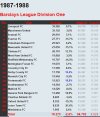Their crowds were low because they were in Division 4.
Taken from football whispers website.....
With debts starting to mount, due to the brothers having difficulty servicing the debt for the newly developed stand, the following season meant the situation became even worse, with no money whatsoever available for players who might just have been able to turn things around.
With former chief scout Sammy Chapman now in charge, Wolves's performances showed no sign of improving. They conceded seventeen goalsin the month of September alone and crowds fell to just 4,000. Worse still, following ground safety regulations that were introduced following the Valley Parade fire of May 1985, two old stands were now closed to the public with a third on the brink of collapse.
With only two sides of the ground open to the public and the new £3 million John Ireland Stand sticking out like a sore thumb, the club and its stadium were a mess as the inevitable happened. Wolves were relegated yet again, this time into Division Four of the Football League for the first time in the club’s history.
Understandably, discontent grew quickly among the club’s exasperated support, and even filtered down to members of satff and ex-players. Former manager Bill McGarry returned to Molineux in September 1985 to try and turn things around but quit just two months later, saying, “I am not going to be party to the killing of one of the finest clubs in the world.” Things had become so bad that supporters and local community leaders decided if the club was to be saved then urgent action needed to be taken.
Then came a turning point. A meeting was held at the Wolverhampton Civic Centre in 1986 and it was decided that the best way forward would be to encourage creditors to issue the club’s owners with a winding-up order, therefore forcing them to put it up for sale.
The words of the Mayor at the time, George Howells, described perfectly the precarious position the club now found itself in: “If the Bhattis could see Wolves off and develop that sacred piece of turf at Molineux for their own interests, they would do it.”
So on July 1986, with the club once again facing extinction, the very same authorities, who just months earlier looked to be behind the demise of Wolverhampton Wanderers, would eventually come to its rescue with a last-ditch proposal that would for the second time see the club hauled back from the brink.
It was agreed that Wolverhampton Council would purchase Molineux along with the land around the stadium, while a local property developer would pay off the club’s debts if planning permission was granted for a nearby Asda superstore to be built – a deal was struck and the club had been saved.
To the relief of Wolves supporters, the arrangement also meant that the Bhatti brothers’ era had finally came to an end after four long years with the pair disappearing back to Saudi Arabia. Even so, the club was still hanging by a thread and playing in a decaying stadium with three stands literally in ruins.
On the pitch Wolves were finally able to begin the long climb away from the basement of English football and even made the playoffs in 1987 after their first season in the league's lowest tier, eventually losing to Aldershot.
The following season Graham Turner's rejuvenated team regrouped to win Division Four and the Sherpa Van Trophy. It was just the boost the club needed and, powered by the strike force of Steve Bull and Andy Much, the Division Three championship followed just 12 months later as the consecutive relegations of the 1980s were matched by consecutive promotions in the 1990s.

